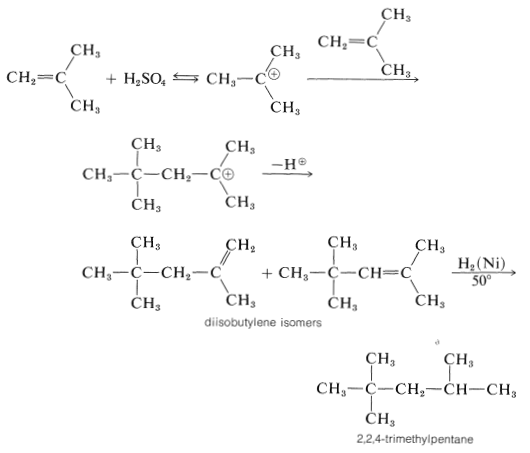
Cationic Polymerization
 المؤلف:
John D. Roberts and Marjorie C. Caserio
المؤلف:
John D. Roberts and Marjorie C. Caserio
 المصدر:
Basic Principles of Organic Chemistry : LibreTexts project
المصدر:
Basic Principles of Organic Chemistry : LibreTexts project
 الجزء والصفحة:
........
الجزء والصفحة:
........
 19-1-2022
19-1-2022
 3378
3378
Cationic Polymerization
Polymerization of an alkene by acidic reagents can be formulated by a mechanism similar to the addition of hydrogen halides to alkene linkages. First, a proton from a suitable acid adds to an alkene to yield a carbocation. Then, in the absence of any other reasonably strong nucleophilic reagent, another alkene molecule donates an electron pair and forms a longer-chain cation. Continuation of this process can lead to a high-molecular-weight cation. Termination can occur by loss of a proton. The following equations represent the overall reaction sequence:

Ethene does not polymerize by the cationic mechanism because it does not have sufficiently electron-donating groups to permit easy formation of the intermediate growing-chain cation. 2-Methylpropene has electron-donating alkyl groups and polymerizes much more easily than ethene by this type of mechanism. The usual catalysts for cationic polymerization of 2-methylpropene are sulfuric acid, hydrogen fluoride, or a complex of boron trifluoride and water. Under nearly anhydrous conditions a very long chain polymer called polyisobutylene is formed.

Polyisobutylene fractions of particular molecular weights are very tacky and are used as adhesives for pressure-sealing tapes.
In the presence of 60% sulfuric acid, 2-methylpropene is not converted to a long-chain polymer, but to a mixture of eight-carbon alkenes. The mechanism is like that of the polymerization of 2-methylpropene under nearly anhydrous conditions, except that chain termination occurs after only one 2-methylpropene molecule has been added:

The short chain length is due to the high water concentration; the intermediate carbocation loses a proton to water before it can react with another alkene molecule.
The proton can be lost in two different ways, and a mixture of alkene isomers is obtained. The alkene mixture is known as "diisobutylene" and has a number of commercial uses. Hydrogenation yields 2,2,4-trimethylpentane (often erroneously called "isooctane"), which is used as the standard "100 antiknock rating" fuel for internal-combustion gasoline engines:

 الاكثر قراءة في المركبات الوسطية وميكانيكيات التفاعلات العضوية
الاكثر قراءة في المركبات الوسطية وميكانيكيات التفاعلات العضوية
 اخر الاخبار
اخر الاخبار
اخبار العتبة العباسية المقدسة


